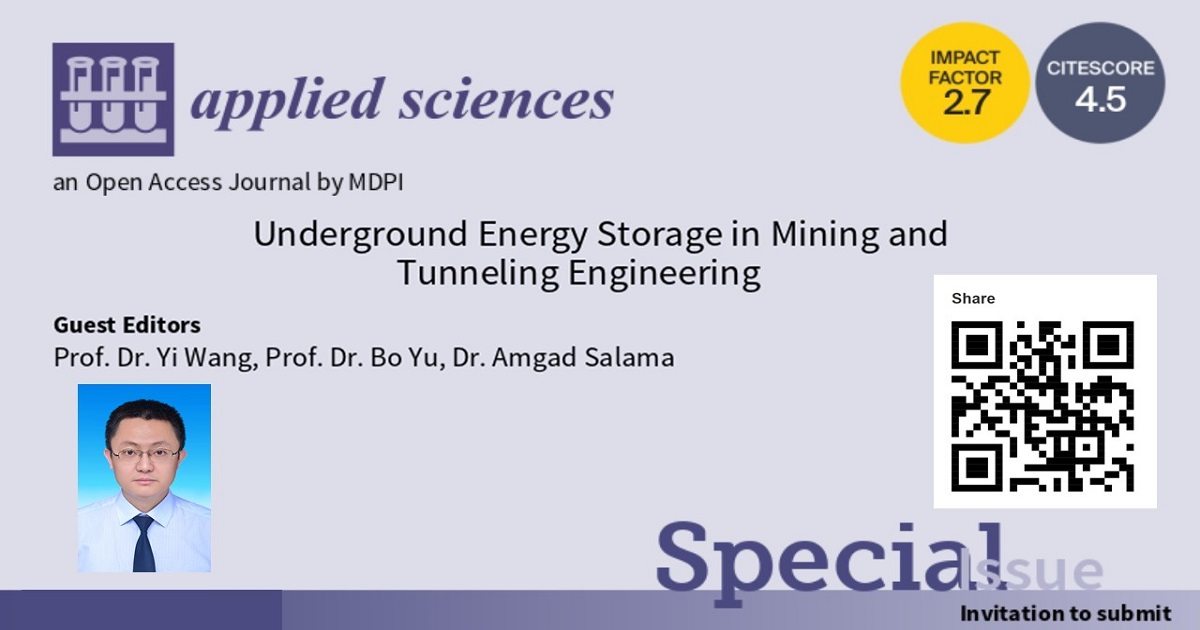Underground Energy Storage in Mining and Tunneling Engineering
A special issue of Applied Sciences (ISSN 2076-3417). This special issue belongs to the section "Energy Science and Technology".
Deadline for manuscript submissions: closed (20 May 2024) | Viewed by 2717

Special Issue Editors
Interests: underground gas storage; pipleine transportation simulation; hydrogen energy; numerical heat transfer
Special Issues, Collections and Topics in MDPI journals
Interests: numerical heat transfer; hydrogen energy; renewable energy
Interests: capillarity; mmicrofluidics; porous media; membranes; heat and mass transfer; numerical methods
Special Issues, Collections and Topics in MDPI journals
Special Issue Information
Dear Colleagues,
Underground storage of energy resources is a promising technology. It offers a large storage capacity for both conventional and unconventional resources. Although subsurface reservoirs have been proposed and utilized as potential storage sites for troublesome gases (e.g., CO2), the current needs for large-scale storage of energy resources have opened several discussions on their potential use of storing energy resources. In fact, subsurface storage of natural gas in salt caverns has been in use for decades. On the other hand, hydrogen is considered a potential player for net-zero emission energy systems. In order for hydrogen to find a viable contribution to future energy share, it is required that large-scale storage systems of hydrogen are secured. Subsurface reservoirs, including mined salt caverns, depleted reservoirs, or aquifers, can, most effectively, achieve this goal. On the other hand, underground water can be used as a high-capacity thermal energy storage due to the larger heat capacity of water. Furthermore, subsurface thermal energy sources due to the higher temperature of the interior of the Earth, which manifests what is known as geothermal energy, is another venue of the wide variety of possibilities subsurface reservoirs may offer. Other energy resources that can benefit from the large storage capacity of subsurface reservoirs include compressed air, which can be used back and forth when needed. These wide varieties of applications and possibilities suggest the need for comprehensive research and studies on the feasibility of these options to identify frameworks, solutions, benefits and drawbacks. To introduce the latest advancements in theoretical, numerical and experimental research as well as industrial applications of subsurface reservoirs as potential energy storage systems, this Special Issue aims to collect recent developments in this regard. It focuses on, but is not limited to, topics relevant to underground energy storage in mining and tunneling engineering, oil and gas engineering, thermal engineering, etc.
Prof. Dr. Yi Wang
Prof. Dr. Bo Yu
Dr. Amgad Salama
Guest Editors
Manuscript Submission Information
Manuscripts should be submitted online at www.mdpi.com by registering and logging in to this website. Once you are registered, click here to go to the submission form. Manuscripts can be submitted until the deadline. All submissions that pass pre-check are peer-reviewed. Accepted papers will be published continuously in the journal (as soon as accepted) and will be listed together on the special issue website. Research articles, review articles as well as short communications are invited. For planned papers, a title and short abstract (about 250 words) can be sent to the Editorial Office for assessment.
Submitted manuscripts should not have been published previously, nor be under consideration for publication elsewhere (except conference proceedings papers). All manuscripts are thoroughly refereed through a single-blind peer-review process. A guide for authors and other relevant information for submission of manuscripts is available on the Instructions for Authors page. Applied Sciences is an international peer-reviewed open access semimonthly journal published by MDPI.
Please visit the Instructions for Authors page before submitting a manuscript. The Article Processing Charge (APC) for publication in this open access journal is 2400 CHF (Swiss Francs). Submitted papers should be well formatted and use good English. Authors may use MDPI's English editing service prior to publication or during author revisions.
Keywords
- underground natural gas storage
- underground hydrogen storage
- aquifer thermal energy storage
- underground compressed air storage
- hydrogen energy
- geothermal energy
- depleted oil/gas reservoirs
- salt carven
- reservoir simulation
- mathematical modeling
- experiments
- computational algorithms
- case study
- industrial application
Benefits of Publishing in a Special Issue
- Ease of navigation: Grouping papers by topic helps scholars navigate broad scope journals more efficiently.
- Greater discoverability: Special Issues support the reach and impact of scientific research. Articles in Special Issues are more discoverable and cited more frequently.
- Expansion of research network: Special Issues facilitate connections among authors, fostering scientific collaborations.
- External promotion: Articles in Special Issues are often promoted through the journal's social media, increasing their visibility.
- Reprint: MDPI Books provides the opportunity to republish successful Special Issues in book format, both online and in print.
Further information on MDPI's Special Issue policies can be found here.







